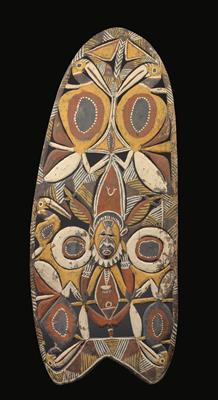New Guinea, Maprik District, Tribe: Abelam: A relief painted with an ancestor figure and birds, painted on both sides. For decorating the interior of a mens’ dwelling.
New Guinea, Maprik District, Tribe: Abelam: A relief painted with an ancestor figure and birds, painted on both sides. For decorating the interior of a mens’ dwelling.

Among the Abelam, on the north coast of New Guinea, cult- and mens’ dwellings exist which are up to 25 metres in height, with triangular facades painted with many figures and faces of important ancestors. Such reliefs, carved and painted on both sides, are made to decorate the interior. The present openwork relief is made of lightweight, light-coloured wood, carved from a single sheet and painted in earth tones: dark grey, white, red and yellow.
Both sides display an ancestor figure at their centre, with a three-dimensionally carved face. On one side, a male ancestor is depicted (‘the tribal father’). It is not quite clear whether the figure on the rear is a woman. Usually, these reliefs depict a ‘tribal parent couple’ – but that is not always necessarily so. The ancestor figures in the centre are each surrounded by five ‘sacred’ birds (hornbills) in openwork relief. The panel is closed off at the exterior by a narrow, carved border.
The fragility and delicacy of the piece is due to the fact that, in the Abelam and related tribes (Wosera, Arapesh, et al.), only experienced professional artisans carve and paint all ritual objects. The finely and expertly crafted relief panel displays some understandable age-related damage: Colour scuffed on both sides and cracks at ‘sensitive' areas, partly fixed with earlier original repairs, partly glued and connected at a later date.
First half to mid-20th century; H: 100 cm, W: 41 cm.
Provenance: An Australian ‘bush pilot’ with German roots who regularly flew between Australia and New Guinea in a small plane during the 1960s brought this piece from New Guinea to Australia on one of his flights. More than 40 years ago, a German purchased it in Australia from the pilot. Currently: German Private Collection. (ME)
Lit.: ‘Ozeanische Kunst’ by Anthony J. P. Meyer, ill. 321, 322; ‘Art Papou’, catalogue Musées de Marseille, ill. 301; ‘Melanesien. Schwarze Inseln der Südsee’, catalogue, Kunsthalle Köln, ill. 213 to 226.
Esperto: Prof. Erwin Melchardt
 Prof. Erwin Melchardt
Prof. Erwin Melchardt
+43-1-515 60-465
erwin.melchardt@dorotheum.at
26.05.2015 - 15:00
- Prezzo realizzato: **
-
EUR 1.500,-
- Stima:
-
EUR 2.400,- a EUR 3.600,-
New Guinea, Maprik District, Tribe: Abelam: A relief painted with an ancestor figure and birds, painted on both sides. For decorating the interior of a mens’ dwelling.
Among the Abelam, on the north coast of New Guinea, cult- and mens’ dwellings exist which are up to 25 metres in height, with triangular facades painted with many figures and faces of important ancestors. Such reliefs, carved and painted on both sides, are made to decorate the interior. The present openwork relief is made of lightweight, light-coloured wood, carved from a single sheet and painted in earth tones: dark grey, white, red and yellow.
Both sides display an ancestor figure at their centre, with a three-dimensionally carved face. On one side, a male ancestor is depicted (‘the tribal father’). It is not quite clear whether the figure on the rear is a woman. Usually, these reliefs depict a ‘tribal parent couple’ – but that is not always necessarily so. The ancestor figures in the centre are each surrounded by five ‘sacred’ birds (hornbills) in openwork relief. The panel is closed off at the exterior by a narrow, carved border.
The fragility and delicacy of the piece is due to the fact that, in the Abelam and related tribes (Wosera, Arapesh, et al.), only experienced professional artisans carve and paint all ritual objects. The finely and expertly crafted relief panel displays some understandable age-related damage: Colour scuffed on both sides and cracks at ‘sensitive' areas, partly fixed with earlier original repairs, partly glued and connected at a later date.
First half to mid-20th century; H: 100 cm, W: 41 cm.
Provenance: An Australian ‘bush pilot’ with German roots who regularly flew between Australia and New Guinea in a small plane during the 1960s brought this piece from New Guinea to Australia on one of his flights. More than 40 years ago, a German purchased it in Australia from the pilot. Currently: German Private Collection. (ME)
Lit.: ‘Ozeanische Kunst’ by Anthony J. P. Meyer, ill. 321, 322; ‘Art Papou’, catalogue Musées de Marseille, ill. 301; ‘Melanesien. Schwarze Inseln der Südsee’, catalogue, Kunsthalle Köln, ill. 213 to 226.
Esperto: Prof. Erwin Melchardt
 Prof. Erwin Melchardt
Prof. Erwin Melchardt
+43-1-515 60-465
erwin.melchardt@dorotheum.at
|
Hotline dell'acquirente
lun-ven: 10.00 - 17.00
kundendienst@dorotheum.at +43 1 515 60 200 |
| Asta: | Arte Tribale |
| Tipo d'asta: | Asta in sala |
| Data: | 26.05.2015 - 15:00 |
| Luogo dell'asta: | Wien | Palais Dorotheum |
| Esposizione: | 20.05. - 26.05.2015 |
** Prezzo d’acquisto comprensivo dei diritti d’asta acquirente e IVA
Non è più possibile effettuare un ordine di acquisto su Internet. L'asta è in preparazione o è già stata eseguita.
